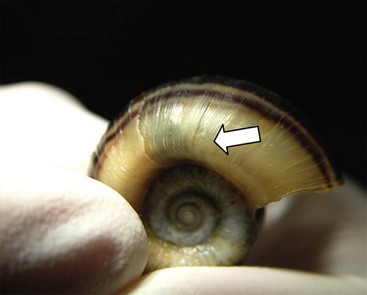Diagnostic Sampling
Diagnostic Sampling
Procedure
 To assess physiologic parameters, hemolymph samples may be obtained.
To assess physiologic parameters, hemolymph samples may be obtained.
 The small sample amount, not to exceed 10% of patient body weight, can make sampling difficult. In mollusks, hemolymph may be obtained from the heart or the cephalopod sinus by means of a capillary tube or a 25-gauge needle and syringe.
The small sample amount, not to exceed 10% of patient body weight, can make sampling difficult. In mollusks, hemolymph may be obtained from the heart or the cephalopod sinus by means of a capillary tube or a 25-gauge needle and syringe.
 To access the heart, a hole may be made in the shell using a dental drill.
To access the heart, a hole may be made in the shell using a dental drill.
 Alternatively, hemolymph can be sampled from the cephalopedal sinus in anesthetized patients.
Alternatively, hemolymph can be sampled from the cephalopedal sinus in anesthetized patients.
 In bivalve mollusks, once the adductor muscle is transected and the left valve is removed, the heart can be found by its beating.
In bivalve mollusks, once the adductor muscle is transected and the left valve is removed, the heart can be found by its beating.
 Alternatively, one may file a notch in each valve to create an opening and then insert the needle into the adductor sinus through the adductor muscle.
Alternatively, one may file a notch in each valve to create an opening and then insert the needle into the adductor sinus through the adductor muscle.
 Another method for bleeding snails may be done without shell perforation. Locate the pneumostome (respiratory opening) as a landmark by watching for the appearance of bubbles.
Another method for bleeding snails may be done without shell perforation. Locate the pneumostome (respiratory opening) as a landmark by watching for the appearance of bubbles.

Pneumostome in the snail may be found by looking for the expulsion of air bubbles. Arrow denotes the light shadow of the air bubbles visualized through the right side of the shell. (Photo courtesy Braun ME, Heatley JJ, Chitty J: Clinical Techniques of Invertebrates, Vet Clin North Am Exot Anim Pract 9:205–221, 2006.)![]()
Stay updated, free articles. Join our Telegram channel

Full access? Get Clinical Tree


Diagnostic Sampling
Only gold members can continue reading. Log In or Register to continue
